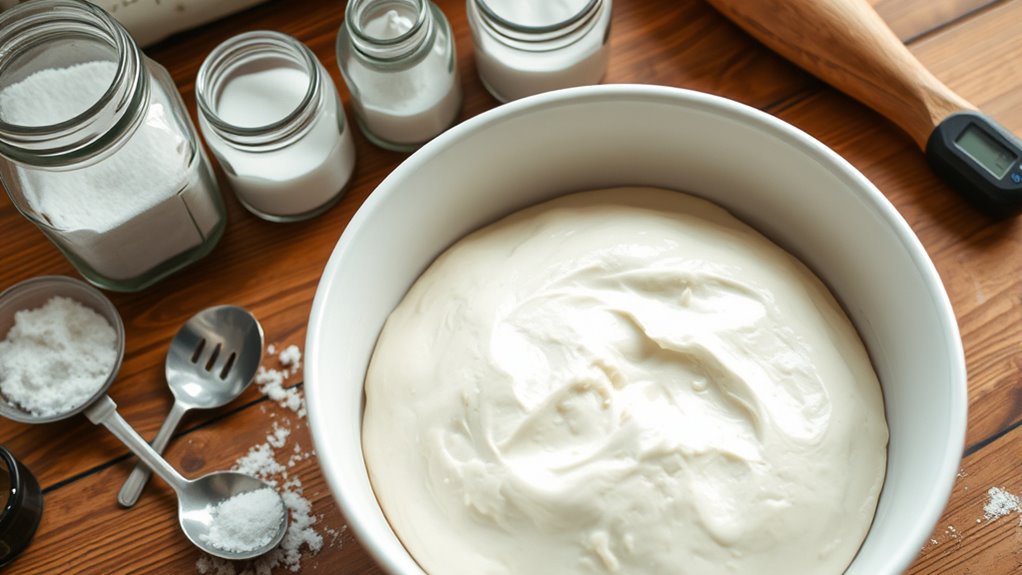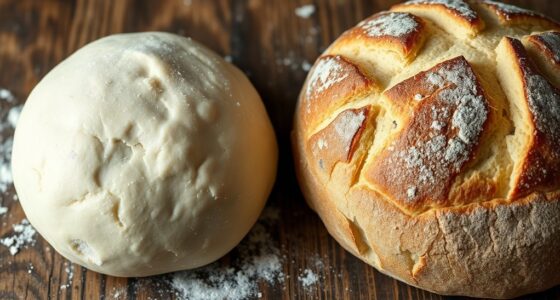Before you start, understand that quick doughs can turn out just as tasty and textured as traditional ones when you use the right techniques. Don’t believe the myth that fast rise means flavor or gluten development suffer; proper kneading, warm liquids, and ingredient quality are key. Planning ahead and handling your ingredients correctly will boost your confidence. Keep going, and you’ll discover how to make consistently delicious same-day doughs every time.
Key Takeaways
- Proper kneading and warm liquids promote rapid gluten development, ensuring good dough texture in same-day baking.
- Quick doughs can achieve flavor and chewiness with correct technique, countering myths of inferior quality.
- Use quality ingredients and accurate measurements for consistent, successful same-day results.
- Seasonal adjustments and proper storage enhance dough flavor, texture, and freshness.
- Understanding and applying these principles prevent common pitfalls and ensure reliable, delicious quick doughs.
Common Misconceptions About Quick Doughs
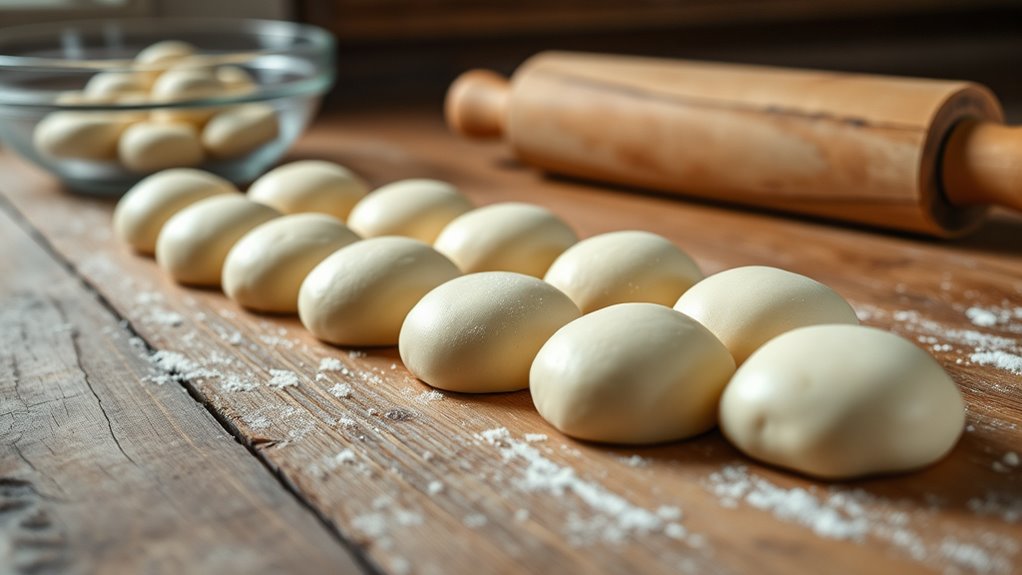
Many people believe that quick doughs are less flavorful or lack the texture of traditional doughs, but this isn’t necessarily true. The misconception often stems from the idea that a quick rise doesn’t allow enough gluten development, which is essential for dough structure. However, with proper technique, you can achieve good gluten formation in a shorter time. Using warm liquids and appropriate kneading helps develop the gluten quickly, giving your dough the elasticity and chewiness typical of longer-rise recipes. Quick rise methods are designed to speed up fermentation without sacrificing flavor or texture. When done correctly, your dough will have the right balance of tenderness and structure, proving that fast doesn’t mean inferior. Additionally, understanding seasonal variations can help you adjust your process to optimize flavor and texture in quick doughs.
Essential Truths for Successful Same-Day Baking
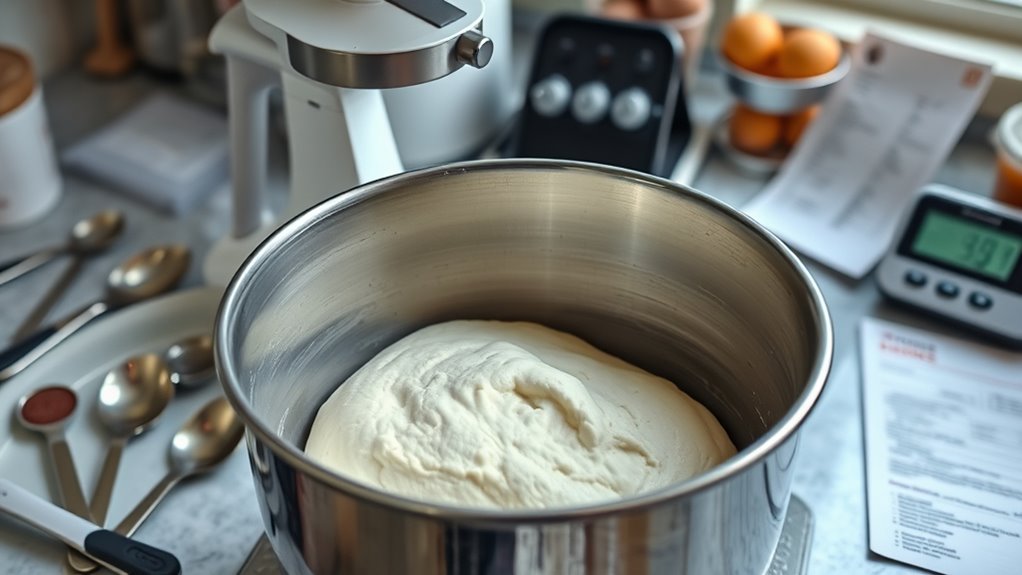
Achieving successful same-day baking hinges on understanding a few essential truths that guarantee your process is efficient and your results are satisfying. First, using the right ingredient substitutions can save time without sacrificing quality. For example, swapping bread flour for all-purpose flour works in many recipes. Second, mastering storage techniques keeps your dough fresh and ready to use. Proper wrapping and refrigeration prevent drying out and fermentation issues. Remember, planning ahead with these truths ensures your baking is smooth and predictable. Additionally, understanding the importance of contrast ratio in your equipment can help you achieve optimal visual results in your baking presentations.
Practical Tips to Avoid Pitfalls and Achieve Perfect Results
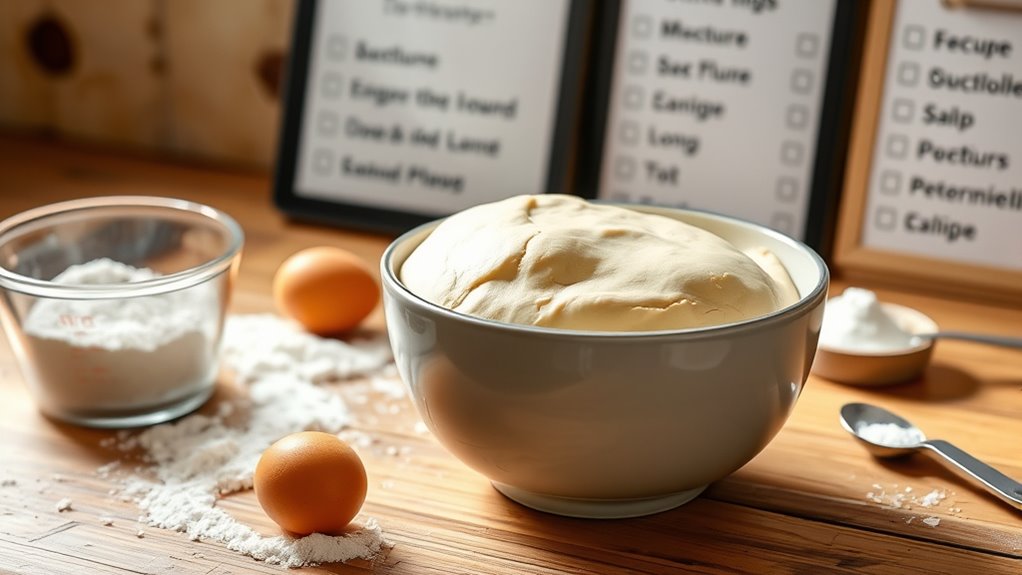
To avoid common pitfalls and guarantee your baked goods turn out perfect, you need to pay close attention to detail throughout the process. Carefully consider ingredient substitutions—use alternatives only when necessary, and make sure they won’t alter the recipe’s texture or flavor. Stick to the measurements and avoid improvising, as this can affect the dough’s consistency. Proper storage tips are also essential; store ingredients correctly to maintain freshness and prevent spoilage, especially for perishables like dairy or eggs. Vetted Quality ingredients can significantly impact your results, so choose reputable sources to ensure freshness. Once baked, follow recommended storage methods for leftovers to keep your dough fresh and prevent staleness. By paying attention to these practical tips, you’ll minimize mistakes and guarantee consistent, delicious results every time.
Frequently Asked Questions
Can I Substitute Different Types of Flour in Same-Day Dough Recipes?
Yes, you can substitute different types of flour in same-day dough recipes, but keep in mind that flour substitution affects gluten development and dough texture. For example, using whole wheat flour instead of all-purpose may result in a denser loaf because it develops less gluten. To guarantee success, adjust hydration levels and knead longer if needed, helping your dough maintain proper elasticity and structure despite the flour swap.
How Can I Tell if My Quick Dough Has Risen Properly?
You’ll know your quick dough has proofed perfectly when it doubles in size, feels light and airy, and shows visible signs of expansion. Look for visual indicators like a puffy surface, a slight bounce when touched, and a gentle spring-back. Proofing perfection means these signs align, confirming your dough’s readiness. Trust these visual cues, and you’ll achieve the ideal rise every time, ensuring your baked goods turn out just right.
Are There Specific Ingredients That Hinder Quick Dough Development?
Certain ingredients can hinder quick dough development, especially those that interfere with gluten development and yeast activation. Avoid excessive salt, which can slow yeast activity, and fats like butter or oil, that can coat gluten strands and weaken structure. Using cold liquids also slows yeast activation, so opt for warm liquids to promote faster fermentation. Stay mindful of these ingredients to guarantee your dough rises quickly and develops the right texture.
What’s the Best Way to Store Leftover Same-Day Dough?
To store leftover same-day dough, wrap it tightly in plastic wrap or place it in an airtight container to prevent drying out. Refrigeration tips include keeping the dough chilled at or below 40°F and using it within 24 hours for best results. Proper dough storage guarantees it remains fresh and ready to use later, helping you avoid overproofing or spoilage. Always label your stored dough with the date for easy tracking.
How Do Altitude and Humidity Affect Quick Dough Baking?
Altitude adjustments and humidity impacts can profoundly affect your quick dough baking. At higher altitudes, you may need to increase liquid or decrease leavening agents to prevent over-rising. Humidity can make the dough sticky or dry, so adjust flour or moisture accordingly. Keep an eye on your dough’s consistency and make small tweaks as needed to ensure perfect baking results, regardless of altitude or humidity.
Conclusion
Now that you know the myths and facts about same-day dough, you’re ready to bake like a pro—no need to wait forever or doubt yourself. Remember, patience and precision are your best friends, just like a trusty sidekick in a classic adventure. With these tips, you’ll master quick doughs and impress everyone with your skills. So roll up your sleeves, embrace the process, and enjoy the sweet smell of success—no flux capacitor required!
